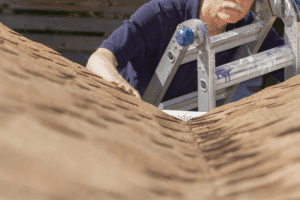Your roof is one of the most important parts of your home, yet it’s often overlooked until a problem arises. Having a roof maintenance checklist can save you from costly repairs and unexpected leaks. In Gaithersburg, MD, where heavy rain, humid summers, and occasional winter storms put extra stress on roofing systems, homeowners need a clear plan to keep their roofs in top shape.
This guide provides a step-by-step roof maintenance checklist that helps protect your home, extend the lifespan of your roof, and give you peace of mind year-round.
Why Roof Maintenance Matters in Gaithersburg

The weather in Gaithersburg can be unpredictable hot summers, cold winters, and seasonal storms all taking a toll on your roof. Without regular upkeep, small issues such as missing shingles, clogged gutters, or cracked flashing can escalate into expensive repairs. A well-structured roof maintenance plan ensures:
- Early detection of damage
- Longer roof lifespan
- Fewer emergency repairs
- Better energy efficiency
- Increased home value
By following a checklist, you’ll catch problems before they escalate.
Roof Maintenance Checklist for Homeowners
Here’s a practical, step-by-step roof maintenance checklist designed specifically for homeowners in Gaithersburg, MD:
Inspect Shingles and Roofing Materials
- Look for missing, curled, or cracked shingles after storms.
- Check tile or metal roofs for cracks, loose tiles, or rust spots.
- Even a single damaged shingle can allow water to seep in and compromise your roof’s underlayment.
- Use binoculars from the ground if climbing is unsafe, or hire a professional roofer.
- Consistent shingle inspections extend the life of your roof and keep small problems from becoming costly emergencies.
Clean Gutters and Downspouts
- Clear gutters at least twice a year—spring and fall—and more often after heavy storms.
- Overflowing gutters can erode your foundation, stain siding, and cause basement flooding.
- Consider installing gutter guards to reduce debris buildup and ensure water flows away from your home.
- Keeping your gutters clean also helps prevent ice dams in the winter and reduces water pooling around your home.
- It’s one of the simplest steps you can take to protect both your roof and your property’s structure.
Check Flashing and Sealants
- Inspect flashing around chimneys, vents, and skylights for cracks or gaps.
- Pay close attention to areas where roof sections meet, as these are common leak points.
- Even small cracks in sealant can lead to significant interior damage.
- Professional resealing is often quick and inexpensive compared to water damage repairs.
- Regularly maintaining flashing can prevent long-term leaks and improve the durability of your roofing system.
Look for Signs of Mold or Algae
- Maryland’s humid climate encourages moss, algae, and mold growth.
- Green or black streaks can weaken shingles and shorten roof life.
- Zinc or copper strips can help prevent regrowth.
- Mold isn’t just a cosmetic issue it can compromise indoor air quality and create health risks.
- Scheduling professional roof cleaning every few years can keep your home looking good and your shingles in top shape.
Examine the Attic
- Check for water stains, mold, or damp insulation—common signs of roof leaks.
- Use a flashlight to inspect rafters and corners for hidden leaks.
- Proper attic ventilation extends your roof’s life and lowers energy costs.
- If you see sunlight coming through, that’s a clear sign of a hole or gap in your roof.
- Addressing attic issues early protects your roof from both water and structural damage.
Trim Overhanging Branches
- Cut back branches that scrape shingles, clog gutters, or act as pathways for pests.
- Dropped leaves and twigs can speed up moss or algae growth.
- Trimming improves sunlight exposure, helping your roof dry faster after rain.
- It also reduces the risk of heavy limbs falling on your roof during storms.
- As a bonus, trimming trees near your home can also improve curb appeal and reduce pest activity.
Schedule Professional Inspections
- Book an annual roof inspection to catch issues early.
- Professionals use tools like drones or infrared to detect hidden weak spots.
- A yearly inspection is far cheaper than emergency storm repairs.
- Roofers can also give you a clearer idea of when a replacement might be needed, so you can budget ahead of time.
- Having a professional inspection report also comes in handy if you ever sell your home it reassures potential buyers that the roof is well cared for.
When to Call a Professional Roofer
Some maintenance tasks can be done on your own, but not everything should be a DIY project. Call a professional roofer if you notice:
- Persistent leaks or water stains on ceilings
- Large areas of missing or damaged shingles
- Sagging or uneven rooflines
- Frequent mold growth despite cleaning
- Damage after severe storms
Hiring a professional ensures safe, high-quality repairs that protect your home long term.
Conclusion
A roof maintenance checklist is a simple but powerful way to protect your home, especially in Gaithersburg, where changing seasons and heavy storms can quickly wear down your roof. By staying on top of regular tasks like inspecting shingles, cleaning gutters, and checking your attic, you can prevent small issues from turning into costly repairs.
And while many of these steps are easy to handle on your own, it’s always wise to call a professional roofer if you notice serious damage, leaks, or anything that feels unsafe, because keeping your roof strong means keeping your home safe.


